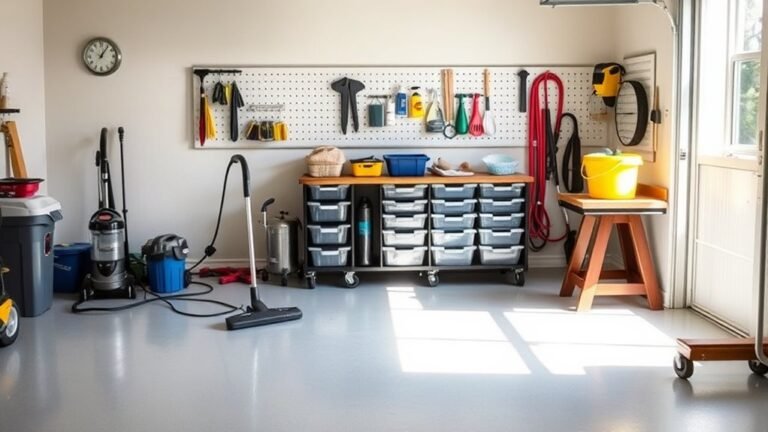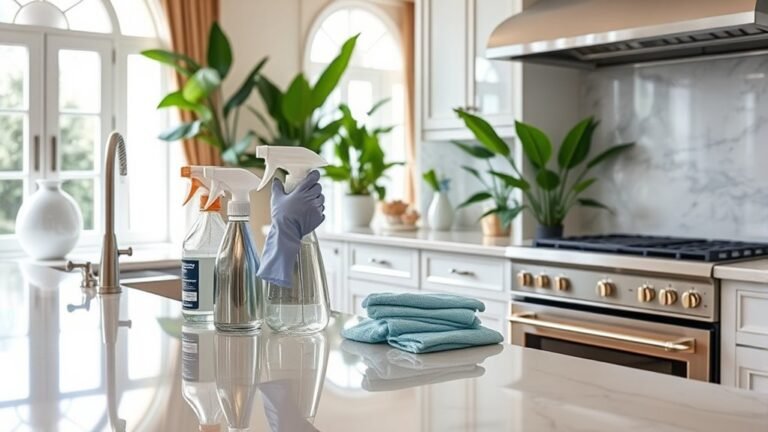Deep Cleaning Guide for Mold Flooring
If you’re dealing with mold on your flooring, start by addressing moisture sources and improving ventilation to prevent spores from spreading. Clear the area, wear protective gear, and choose the right cleaner—vinegar for a natural option or a commercial remover for tougher mold. Scrub thoroughly, dry completely, and monitor humidity below 60% to stop mold from returning. Follow these steps carefully, and you’ll be on your way to a cleaner, healthier home; understanding each part in detail helps you tackle the problem effectively.
Understanding the Causes of Mold on Flooring

Although mold can appear suddenly on your flooring, it usually develops because of persistent moisture problems. When you’re dealing with mold growth, understanding its root causes is key to reclaiming your space. Mold thrives in damp environments, so without proper humidity control, it’s easy for moisture to linger unnoticed. You might not realize how everyday habits—like spills, leaks, or poor ventilation—contribute to creating the perfect conditions for mold. By staying vigilant and managing humidity levels, you can prevent mold from taking hold and limit its spread. Remember, your freedom to enjoy a clean, safe home starts with controlling moisture and interrupting mold’s growth cycle before it becomes a bigger problem that restricts your space and peace of mind.
Identifying Different Types of Mold
How can you tell which type of mold is growing on your flooring? Recognizing mold types is key to managing health risks and reclaiming your space. Here’s a quick guide:
Identifying mold types on your flooring is essential for health and effective cleanup.
- Black Mold – Often dark and slimy, linked to respiratory issues.
- White Mold – Powdery and less obvious, but still a threat to air quality.
- Green Mold – Usually fuzzy and vibrant, can cause allergic reactions.
- Pink Mold – Actually a bacteria, it thrives in damp areas and impacts breathing.
Knowing these mold types helps you take control and choose the right cleaning approach. Don’t let mold limit your freedom—identify it early to protect your health and restore your flooring confidently.
Preparing Your Space for Mold Removal

Before you start cleaning, make sure to clear the area and open windows for good ventilation. You’ll also want to gather protective gear like gloves and masks to keep yourself safe. Don’t forget to remove any furniture or rugs that could get in the way or harbor mold spores.
Clear and Ventilate Area
Since mold spores can easily spread through the air, you’ll want to clear the area of any furniture or items that might get contaminated. Creating an open, well-ventilated space is key to gaining control over mold. Here’s how to set yourself up for success:
- Remove all movable objects to prevent cross-contamination.
- Open windows and doors to maximize airflow.
- Use fans strategically to boost ventilation techniques without pushing spores into other rooms.
- Monitor indoor humidity, keeping it below 60% to discourage mold growth.
Gather Protective Gear
Anyone tackling mold removal should start by gathering the right protective gear to keep themselves safe throughout the process. Mold spores can irritate your skin, eyes, and lungs, so don’t skip this step. You’ll want to put on protective clothing that covers your arms and legs completely—think long sleeves, pants, and gloves—to prevent direct contact with the mold. Safety goggles are a must to shield your eyes from airborne particles, especially when scrubbing or using cleaning solutions. A well-fitting mask or respirator will protect your lungs, but focus on the clothing and goggles first. Preparing properly means you can work freely and confidently, knowing you’re shielded from health risks while reclaiming your space from mold.
Remove Furniture and Rugs
To prepare your space for mold removal, start by clearing out all furniture and rugs from the affected area. This step frees up your floor and helps prevent mold from spreading or damaging your belongings. Proper furniture placement after cleaning can keep your space mold-free longer, so consider this carefully.
Here’s how to approach it:
- Remove all furniture gently to avoid stirring up mold spores.
- Roll up rugs and inspect them for mold before deciding on rug maintenance or professional cleaning.
- Store furniture and rugs in a dry, well-ventilated area.
- Plan new furniture placement to promote airflow and reduce moisture buildup.
Effective Cleaning Solutions for Mold Removal

When tackling mold on your flooring, choosing the right cleaning solution is essential for effective removal and preventing future growth. You have the freedom to decide between natural remedies and chemical solutions based on what fits your lifestyle and comfort level. Natural remedies like vinegar, baking soda, and tea tree oil are powerful, eco-friendly options that work well without harsh fumes. If you prefer a stronger approach, chemical solutions such as bleach or commercial mold removers offer quick, thorough results but require careful handling to protect your health and flooring material. Whichever you pick, make sure it suits your space and safety needs. This choice lets you take control of your environment while staying true to your preferences for a mold-free floor.
Step-by-Step Mold Removal Process
A thorough mold removal process involves several key steps to guarantee your flooring is clean and safe. You want to regain control over your space, free from mold growth that threatens your freedom and comfort. Follow these cleaning techniques:
- Protect yourself with gloves and a mask to avoid exposure.
- Identify and isolate the moldy area to prevent spores from spreading.
- Apply an appropriate mold cleaner, scrubbing the affected spots thoroughly.
- Rinse the floor and dry it completely to stop mold from returning.
Preventative Measures to Keep Mold Away
Although you’ve removed the mold, it’s essential to take steps that keep it from coming back. Start by choosing mold resistant materials for your flooring and surrounding areas—these reduce the chance of mold growth and give you peace of mind. Next, focus on humidity control; mold thrives in damp environments, so keeping indoor humidity below 60% is key. Use dehumidifiers or improve ventilation to maintain dry air. Regularly inspect areas prone to moisture and fix leaks promptly. By staying proactive with these measures, you’ll create a space where mold struggles to survive, giving you the freedom to enjoy your home without worry. Preventing mold isn’t just about cleaning; it’s about setting up your environment for lasting health and comfort.
Frequently Asked Questions
Can Mold on Flooring Affect Indoor Air Quality?
Yes, mold on your flooring can seriously affect indoor air quality. When mold spores become airborne, they turn into indoor pollutants that you end up breathing in. This can lead to health issues like allergies or respiratory problems, limiting your freedom to enjoy your space comfortably. Taking control by addressing mold early helps you keep the air clean and your home a safe, liberating environment where you’re free to live without worry.
Is Professional Mold Remediation Always Necessary?
Sometimes, tackling mold issues means calling in the pros, but it’s not always set in stone. If you’ve got a small patch, you might find DIY remediation techniques effective, giving you the freedom to handle things on your own terms. Just remember, mold prevention strategies are key to keeping your space fresh and safe. When things feel overwhelming, professional help guarantees thorough care, but you’ve got options to steer your own course.
How Long Does Mold Take to Grow on Flooring?
Mold growth timeline on flooring can be surprisingly fast—you’ll often see mold appear within 24 to 48 hours if there’s enough flooring moisture. If your flooring stays damp or wet, mold spores seize the chance to multiply quickly. To keep your space fresh and free, you’ve got to control moisture and act fast. Don’t let mold cramp your style; staying ahead means checking for leaks or spills regularly and drying floors promptly.
Are Certain Flooring Materials More Resistant to Mold?
Imagine your flooring as a brave knight facing a mold invasion—some knights wear stronger armor than others. When it comes to mold resistance, flooring types like tile, vinyl, and sealed concrete are your best allies, standing firm against moisture and mold growth. Wood or carpet, on the other hand, are more vulnerable. Choosing mold-resistant flooring means you’re not just protecting your home but also reclaiming your freedom from constant worry and cleaning battles.
Can Mold Return After Deep Cleaning?
Yes, mold can return after deep cleaning if you don’t keep up with proper flooring maintenance. To truly enjoy a mold-free space, you’ll want to follow mold prevention tips like controlling moisture, improving ventilation, and promptly addressing spills or leaks. Staying proactive means you’re not trapped by recurring mold problems, giving you the freedom to live comfortably without worrying about hidden growth under your feet.






